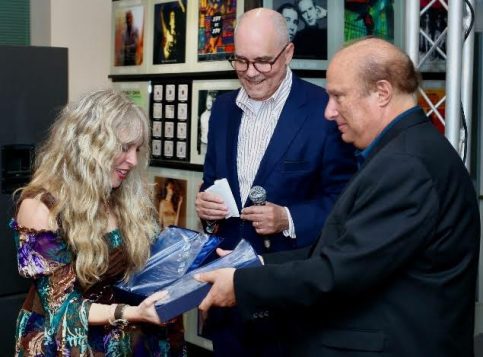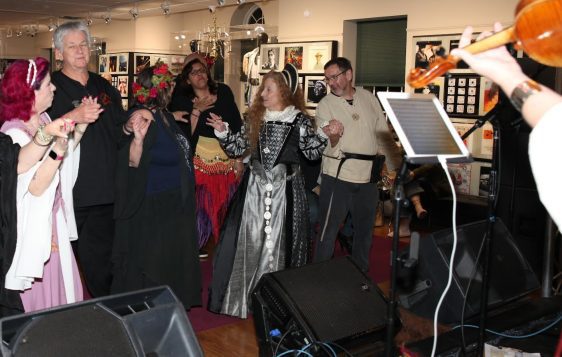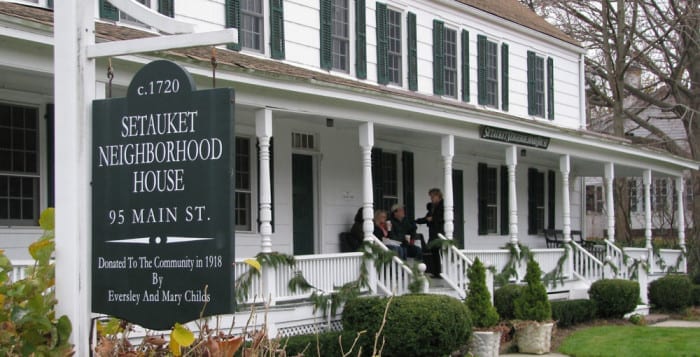The Long Island Music and Entertainment Hall of Fame (LIMEHOF), in coordination with earMUSIC, hosted an evening celebrating Candice Night and the release of her new album, Sea Glass, on May 13. The celebration featured a live solo performance by Night, performing three songs from her new album followed by the official induction of Ritchie Blackmore and Candice Night of Blackmore’s Night into LIMEHOF at its museum, located at 97 Main Street in Stony Brook. Night accepted the induction by LIMEHOF executive board member Robert deBrauwere on behalf of Blackmore’s Night as Blackmore was not able to attend.
“I am so honored to be inducted into the Long Island Music and Entertainment Hall of Fame,” Night said. “Being surrounded by some of the greatest musicians, knowing we all have the same roots here is an incredible feeling. I’ve lived on Long Island my whole life and am constantly inspired by the energy here and the beauty of our nature.”

Blackmore’s Night, the minstrel rock band founded by legendary guitarist Ritchie Blackmore and ethereal singer and multi-instrumentalist Candice Night began in 1997 as a labor of love and an escape from the pressures of the modern-day world. They formed their own musical world, creating a new genre of music. The group has recorded 11 albums. Weaving together melodies from the Renaissance times with modern day instrumentation, original arrangements, and new lyrical content, Blackmore and Night have achieved many awards, critical acclaim and gold records worldwide, consistently topping the Billboard New Age charts.
Together with their 7-piece touring band, they perform in castles and historical venues worldwide. Thousands of fans show up to the shows dressed in period garb to be a part of the musical festivities. They record in their home studio, here on Long Island, and have gained the love and loyalty of millions of fans over the past 28 years.
“It’s an amazing honor for me to induct my long-time friends and clients Candice and Ritchie as Blackmore’s Night into the Long Island Music and Entertainment Hall of Fame,” said deBrauwere. “It’s incredible how popular their music is throughout the world. Particularly in Europe and Japan, but really everywhere, there are Blackmore’s Night fans throughout the world. There’s a huge community of folks that love them.”
The two inductees met on Long Island and have strong Long Island community ties. Ritchie Blackmore (Deep Purple and Rainbow) grew up in the UK and moved to the USA in 1974, moving to Huntington, Long Island in the 1980s.

Candice Night grew up in Hauppauge and is a lifetime Long Island resident and a graduate of NYIT in Old Westbury. While interning at WBAB in 1989, she met Ritchie Blackmore at a charity soccer game where Deep Purple played against the station’s DJ’s and Staff. After the game, Candice asked Ritchie for his autograph and the two became friends, later developing into more. They started living together in 1993 and co-founded Blackmore’s Night in 1997.
They have been very involved in many local charity efforts and community events across Long Island including Save a Pet in Port Jefferson, STAR animal rehabilitation, Little Shelter in Huntington, and the North Shore Animal League. They have raised funds, awareness and supplies for them and set up donation booths over the years at every Blackmore’s Night show, even hosting adopting events at their concerts for some.
Night started singing at Lillian Carans Little Theater Workshop in Smithtown and has recorded music at Richie Cannatas Cove City Sound Studios in Glen Cove with local producer/engineer Brendan Keenan. Candice was also the Snow Queen in the Dickens Festival at Port Jefferson for 2 years, including receiving the 1st artist in residence award.
“In recorded and live performances, Long Island’s Blackmore’s Night has been thrilling and entertaining audiences all around the world for nearly three decades,” said LIMEHOF Co-Founder Norm Prusslin. “Blending renaissance melodies, instrumentals, and folk-rock original songs into a style uniquely their own, Blackmore’s Night is beloved by their fans for their exceptional musicianship, extraordinary vocals, and legendary performances. Blackmore’s Night’s induction into the Long Island Music and Entertainment Hall of Fame recognizes and honors their artistry, creativity and legacy.”







 Welcome to the 41st edition of Paw Prints, a monthly column for animal lovers dedicated to helping shelter pets find their furever home
Welcome to the 41st edition of Paw Prints, a monthly column for animal lovers dedicated to helping shelter pets find their furever home










 New location! Emma Clark Library has moved the Ellen Bogolub Chamber Music Concert to the Setauket Neighborhood House, 95 Main St., Setauket on Sunday, May18 from 2 p.m. to 3 p.m. Join them for an afternoon of Haydn, Mendelssohn, and Florence Price’s “Swing Low, Sweet Chariot” performed by a
New location! Emma Clark Library has moved the Ellen Bogolub Chamber Music Concert to the Setauket Neighborhood House, 95 Main St., Setauket on Sunday, May18 from 2 p.m. to 3 p.m. Join them for an afternoon of Haydn, Mendelssohn, and Florence Price’s “Swing Low, Sweet Chariot” performed by a






